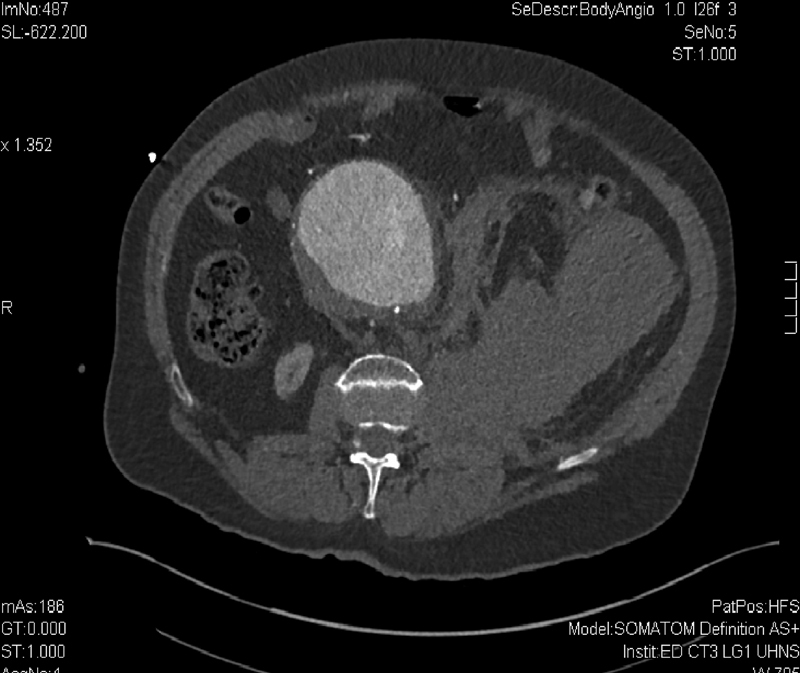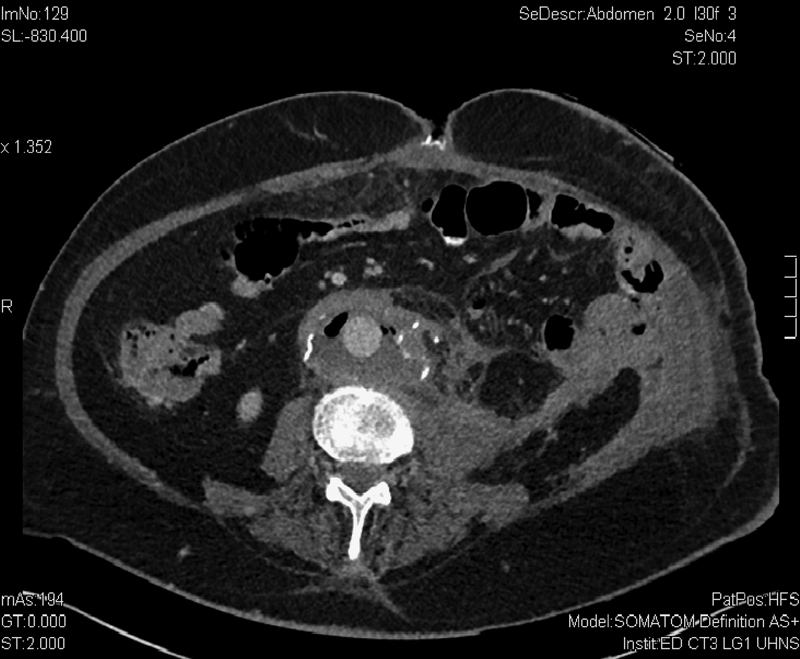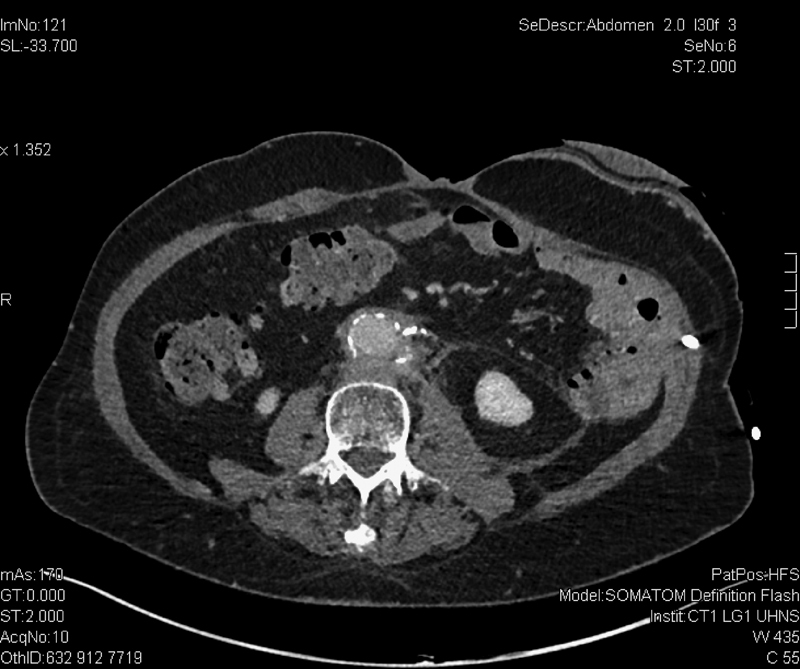Abstract
Conservative management of an aortic graft infection is defined as “the nonresectional treatment of an aortic graft that has an established infection.” Incidence of aortic graft infections is 0.5 to 5% and the estimated mortality rate from aortic graft infections ranges from 8 to 27%.
We present the case of a 73-year-old male patient with an infected abdominal aortic graft following an emergency ruptured abdominal aortic aneurysm repair. Postemergency repair, he developed ischemic colitis with sigmoid colon perforation leading to fecal peritonitis and secondary sepsis. He developed a large infective collection within the aortic sac growing vancomycin-resistant enterococcus sensitive to linezolid. A percutaneous drain was placed in the aortic sac and this was irrigated with linezolid for a total of 28 days. The patient clinically improved. Overall, 7 months later, follow-up scan shows complete resolution of infection and the patient remains clinically stable.
Conventional treatment of aortic graft infections involves an extra-anatomical bypass. Percutaneous drainage and antibiotic use may be used as bridging therapy for surgery or as definitive therapy when surgical treatment is impractical. Most aortic graft infections grow gram-positive cocci, the organisms form a biofilm which is protected from the external environment. Percutaneous drainage and antibiotic irrigation could possibly penetrate the biofilm and eradicate infection. Morris et al conducted a study on 10 patients having irrigation therapy and systemic antibiotic treatment and found a 1-year survival rate of 80%.
In conclusion, conservative aortic graft treatment may be an effective alternative where surgical intervention is not suitable.
Keywords: abdominal aortic aneurysm, infected graft, infection, ischemia, percutaneous, repair, vascular access
The patient is a 73-year-old male with an infected abdominal aortic graft following an emergency ruptured abdominal aortic aneurysm (AAA) repair. There was no significant background history. He presented to the emergency department for computed tomographic (CT) scan which confirmed 10.2 cm ruptured infrarenal AAA. He soon underwent an emergency open repair (Fig. 1).
Fig. 1.

Ruptured aneurysm.
On day 3 postoperatively, the patient developed ischemic colitis with sigmoid colon perforation leading to fecal peritonitis and secondary sepsis. An emergency laparotomy, left hemicolectomy, and transverse colostomy were performed and he was shifted to the intensive care unit for the treatment of consequent multiorgan failure.
After initial improvement, the clinical progress faltered, prompting a further CT scan. This revealed a large intra-abdominal collection. This patient was considered high risk for surgical graft excision because of several factors including the breakdown of his laparotomy wound and the presence of a stoma on the right side of his abdomen. It was then decided at the multidisciplinary team meeting to treat him conservatively and drain the collection percutaneously.
Following further clinical fluctuations, a CT scan had revealed a large collection within the aortic sac. A CT-guided drain was inserted for percutaneous drainage. Fluid samples and blood cultures grew vancomycin-resistant enterococcus (VRE) which was sensitive to linezolid. Overall, 600 mg of linezolid was diluted in 300 mL on normal saline. Overall, 250 mL was administered intravenously and 50 mL of linezolid infusion was irrigated directly into the aortic sac, left in the sac for 2 hours, and then allowed to drain freely. This regime was performed twice daily at 12-hour intervals for a total of 28 days on advice of consultant in infectious disease and microbiology (Fig. 2).
Fig. 2.

Locules of gas and fluid within the aneurysm sac and partially drained left flank collection.
The patient made significant clinical and biochemical improvement. His albumin and inflammatory markers returned to normal levels and before discharge the patient was gaining weight and mobilizing with a frame. A repeat CT performed 33 days following percutaneous drainage showed that the retroperitoneal collection had reduced considerably in size. He was discharged home on oral linezolid (600 mg at 12-hour intervals).
A further 33 days later during follow-up, he developed further left-sided intra-abdominal collection shown on CT which was percutaneously drained. He also developed temporary bone marrow failure secondary to linezolid, which required an antibiotic change to oral metronidazole 400 mg three times daily and ciprofloxacin 500 mg twice daily. Presently, he remains clinically stable, he has continued to gain weight and is managing independently at home. Overall, 7 months following his AAA repair, his follow-up CT scan shows no sign of infection or collection with no percutaneous drain in situ. Multidisciplinary team consensus is for lifelong oral antibiotic therapy with metronidazole (Fig. 3).
Fig. 3.

Resolution of fluid and gas within the aneurysm sac and left-sided flank collection.
Discussion
The conservative management of aortic graft infections is stated as “the nonresectional treatment of an aortic graft that has an established infection”1. The incidence of aortic graft infections following either open or endovascular aneurysm repair is 0.5 to 5% and is associated with limb loss, conduit thrombosis, and recurrent graft infection, all of which have high mortality.1 2 The overall mortality of aortic graft infections is estimated between 8 and 27%.2 Factors affecting the mortality rate include patient comorbidities, extent of graft infections, type of operation undertaken, and the virulence of the infecting organism.2 The mortality of surgical resection of an infected aortic graft is between 25 and 35%.1
Aortic graft infections are most commonly associated with gram-positive cocci, such as Staphylococcus epidermidis and Staphylococcus aureus. Our patient was colonized with gram-positive VRE. Gram-negative bacteria are less common and less suitable for conservative management as they invade local tissue more aggressively and cause anastomotic disruption.1
Many organisms tend to form a biofilm or “slime” around the grafts.3 The bacteria harbor themselves within the biofilm and are protected from the external immunological and antibiotic environment.3 Using highly potent antimicrobials directly may penetrate the biofilm and potentially eliminate the infection.3 By directly administering antibiotics into the aortic sac in this case, it is possible we may have eradicated the graft infection completely or certainly kept it suppressed.
Conservative management is indicated when surgical intervention is impractical.1 Various different regimes have been suggested including open or percutaneous drainage, irrigation with saline or antiseptic agents, and treatment with antimicrobials via intravenous infusion or local application at the site of infection.4 Intravenous antibiotics can be used to control symptoms, control sepsis, and reduce white cell count, but they alone cannot eliminate the infection.1 Oral antibiotics are usually followed on for maintenance after the course of intravenous (IV) antibiotics.1 Most reports recommend the use of IV antibiotics for 6 weeks, whereas some have reported use for 3 to 6 months with lifelong oral antibiotics.2 The early mortality in one of these reports was 11.1%.2
Percutaneous drainage and antibiotic use can be used as bridging therapy for surgery or as a definitive therapy. Methods of treatment include inserting an irrigating drain at the site of infection with continuous irrigation until cultures become negative.1 Morris et al performed a prospective study on 10 patients being treated for graft infections with local irrigation therapy and systemic antibiotic treatment. They found a 1-year survival rate in 80% of cases and 5-year survival rate in 67%. The regime they used was 20 mg of gentamicin in 20 mL normal saline every 2 hours for the first 12 hours, then every 4 hours for the next 12 hours, and then 6 hourly afterward. The dosage was altered according to gentamicin levels. These patients were concurrently given IV gentamicin (80–120 mg once daily), penicillin (1 g four times daily), and metronidazole (500 mg three times a day). Irrigation was continued until three cultures were consecutively negative. The duration of treatment ranged from 12 to 56 days.5
The conventional method of treating aortic graft infections is by performing a complete graft excision followed by either an extra-anatomical bypass (bilateral axillofemoral bypass) or anatomical reconstruction using autologous vein, aortic allografts, or prosthetic graft.2 4 Yeager et al followed a cohort of 60 patients with graft infections who underwent graft excisions and extra-anatomical reconstruction. Overall, 1-year and 5-year survival was observed in 67 and 47% of cases, respectively.6 Rifampicin-bonded prosthetic grafts are also used along with omental or muscle flap, usually as an adjunct to primary therapy.1 2 4 The omentum or muscle flaps provides a rich blood supply for controlling infection.1
Conclusion
Conservative treatment of aortic graft infections may be effective alternative when surgical intervention proves impossible. Conservative antibiotic treatment should include regular cultures, systemic antibiotic treatment, and local irrigation therapy until cultures are negative, followed by oral antibiotics for maintenance with regular follow-up. However, the existence of biofilm may mean that negative cultures do not imply the eradication of infective agents. Therefore, the duration of antibiotic irrigation must be somewhat arbitrary.
Our patient has no residual sign of graft infection. To our knowledge, this is the first reported case of irrigation of the aortic sac with linezolid.
Reference
- 1.Lawrence P F. Conservative treatment of aortic graft infection. Semin Vasc Surg. 2011;24(4):199–204. doi: 10.1053/j.semvascsurg.2011.10.014. [DOI] [PubMed] [Google Scholar]
- 2.Perera G B, Fujitani R M, Kubaska S M. Aortic graft infection: update on management and treatment options. Vasc Endovascular Surg. 2006;40(1):1–10. doi: 10.1177/153857440604000101. [DOI] [PubMed] [Google Scholar]
- 3.Chiesa R, Astore D, Frigerio S. et al. Vascular prosthetic graft infection: epidemiology, bacteriology, pathogenesis and treatment. Acta Chir Belg. 2002;102(4):238–247. doi: 10.1080/00015458.2002.11679305. [DOI] [PubMed] [Google Scholar]
- 4.Wilson S E New alternatives in management of the infected vascular prosthesis Surg Infect (Larchmt) 200122171–175., discussion 175–177 [DOI] [PubMed] [Google Scholar]
- 5.Morris G E, Friend P J, Vassallo D J, Farrington M, Leapman S, Quick C R. Antibiotic irrigation and conservative surgery for major aortic graft infection. J Vasc Surg. 1994;20(1):88–95. doi: 10.1016/0741-5214(94)90179-1. [DOI] [PubMed] [Google Scholar]
- 6.Yeager R A, Taylor L M Jr, Moneta G L. et al. Improved results with conventional management of infrarenal aortic infection. J Vasc Surg. 1999;30(1):76–83. doi: 10.1016/s0741-5214(99)70178-3. [DOI] [PubMed] [Google Scholar]


